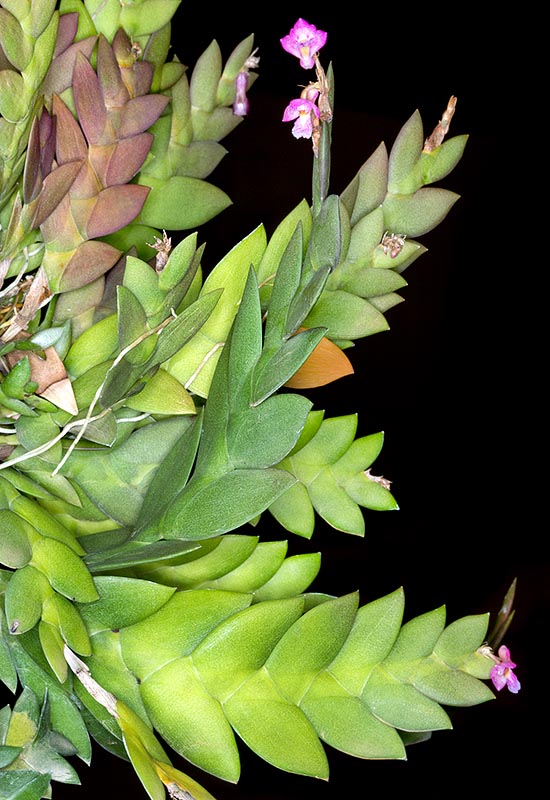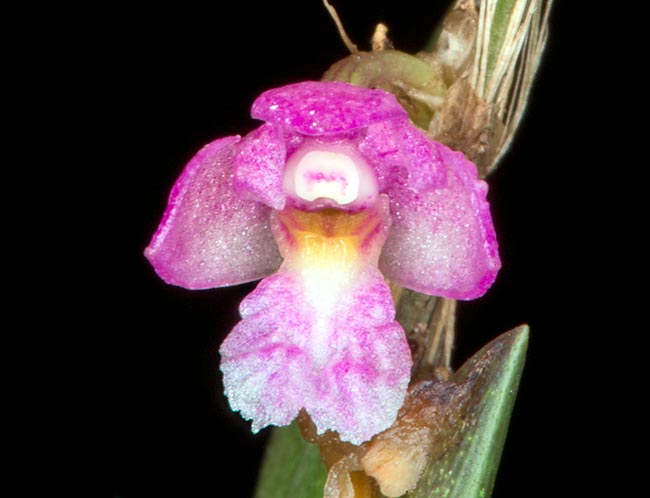Family : Orchidaceae

Text © Pietro Puccio

English translation by Mario Beltramini

Rare in cultivation, Dendrobium rosellum is recognized at once by the typical foliage. Epiphyte, it lives at 1000 m of altitude in the dense Borneo, Malaysia and Sumatra forests © Giuseppe Mazza
The name of the genus is the combination of the Greek substantives “δένδρον” (dendron) = tree and “βίος” (bios) = life, with reference to the numerous species of the genus living on the trees; the name of the species is the Latin adjective “rosellus, a, um” = of pinkish colour, with obvious reference.
Common names: pink spotted dendrobium (English).
The Dendrobium rosellum Ridl. (1896) is an epiphytic species with erect or sub erect pseudobulbs, at times ramified, up to about 35 cm long, provided with alternate, disticous, strictly imbricate, ovate with pointed apex, 1,2-2 cm long and about 2 cm broad, coriaceous, dark green colour leaves.
Flowers from the upper nodes without leaves with purple pink sepals and petals, curved around the column, 10 mm long and of 7 mm of diameter.
Dorsal ovate with pointed apex sepal, 4 mm long and 3 mm broad, the lateral sepals, little wider than the dorsal, merged at the base of the column, form a sort of spur (mentum), enlarged at the apex, 5 mm long, ovate-lanceolate petals smaller than the sepals, trilobed, about 7 mm long, labellum with yellow spot at the base and obovate median lobe with deeply bilobed apex, about 4 mm broad, of pink colour with white spots.
It reproduces by seed, in vitro, and division, to be done at the vegetative restart, with each section provide of at least 3-4 pseudobulbs.
Fairly rare species in cultivation with characteristic foliage and tiny and delicate flowers, short-lasting, few days, but produced in succession, requires high luminosity, but not direct sun, medium-high temperatures, 18-30 °C, high humidity, 70-85%, and air constantly moving.
Regular and abundant waterings during the vegetative period, but allowing the substratum to partially dry up before giving water again, then slightly more spaced up to the vegetative restart.

Pseudobulbs, at times ramified, that can reach 35 cm and tiny flowers of 7 mm of diameter © Giuseppe Mazza
To cultivate mounted on bark, trunks, rafts of cork or arborescent ferns roots or in pots or baskets with particularly draining and aerated compost which may be formed by a mix of medium sliced bark, fragments of charcoal and sphagnum. Transplants and repottings are to be done when strictly necessary by the vegetative restart, signalled by the appearance of the new roots.
The species is reported in the appendix II of the CITES (species whose trade is ruled at international level).
Synonyms: Aporum rosellum (Ridl.) Rauschert (1983).
→ For general notions about ORCHIDACEAE please click here.
